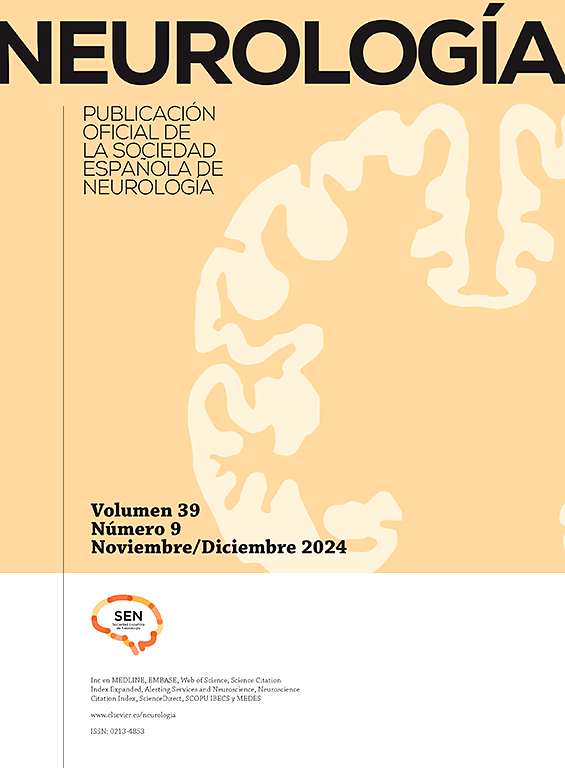Análisis de costes del tratamiento con recambio plasmático terapéutico frente al tratamiento con inmunoglobulinas endovenosas en pacientes con enfermedades neurológicas de base inmune. Propuesta de optimización del uso de hemoderivados plasmáticos
IF 3.1
4区 医学
Q2 CLINICAL NEUROLOGY
引用次数: 0
Abstract
Introduction
Therapeutic plasma exchange (TPE) and/or the administration of endovenous immunoglobulins (IGEV) are considered the first line treatment for multiple autoimmune-based neurological diseases. According to the scientific evidence collected in several recent guidelines, the efficacy of both treatments is very similar for many of them, however, the current situation of non-self-sufficiency and the real risk of IGEV shortages make it essential to assess TPE as the first therapeutic option.
The objective of this work is to estimate the basic direct costs derived from treatment with RPT compared to treatment with IGEV in immune-mediated neurological diseases in a situation of supposed therapeutic equivalence.
Material and methods
Patients who are treated with IGEV receive a standard dose of 0.4 g/Kg weight for 5 consecutive days. Patients treated with RPT with the Terumo-BCT® Optia model cell separator undergo between 5 and 7 sessions, every other day, with a substitution equivalent to 1-1.5 volumes, using 4-5% albumin as replacement fluid.
The calculation of the economic cost, for both types of treatments, in simulation of therapeutic equivalence and safety, has been carried out considering pharmaceutical expenses, calculation of the cost for each dose of IGEV, the detailed costs of consumables, replacement fluids and anticoagulant for RPT, in the worst-case scenario, with central venous catheter (CVC) placement. The price of albumin and immunoglobulins has been adjusted based on the situation of self-sufficiency or dependency and the average value of the last 4 years has been referenced for the calculations. The costs of personnel, hospitalization, or complications derived from the treatments have not been considered. The prices are indicated in euros including VAT of 4% or 21% as appropriate.
Results
For a patient with a mean weight of 70 kg, the estimated final cost per TPR session, with CVC placement, was €612.66; while the cost for each dose of IGEV. (0.4 g/kg) was €1191. The difference is favorable to the RPT: €2,279 [€1,666.4 - €2,891.7]. The economic difference presented is probably greater in real clinical practice, since many of the patients do not require CVC placement to perform the TPR, and sessions were performed on an outpatient basis.
Conclusions
The use of TPE in the first line in pathologies in which the clinical results do not present significant differences with the IGEV, optimizes the use of blood products and can lead to economic savings. It is necessary to expand this study by including an analysis of the efficacy in our series, as well as the adverse events associated with each type of treatment together with other expenses derived from personnel and hospital admission costs versus the use of outpatient resources (pheresis room).
在免疫基神经系统疾病患者中,血浆替代治疗与静脉内免疫球蛋白治疗的成本分析优化血浆血液制品使用的建议
治疗性血浆置换(TPE)和/或静脉内免疫球蛋白(IGEV)被认为是多种自身免疫性神经系统疾病的一线治疗方法。根据最近几份指南中收集的科学证据,两种治疗方法的疗效在许多方面非常相似,然而,目前缺乏自给自足的情况和IGEV短缺的实际风险使得有必要对TPE作为第一治疗选择进行评估。这项工作的目的是估计在假设治疗等效的情况下,在免疫介导的神经系统疾病中,与IGEV治疗相比,RPT治疗的基本直接成本。材料和方法接受IGEV治疗的患者接受标准剂量0.4 g/Kg体重,连续5天。使用Terumo-BCT®Optia模型细胞分离器接受RPT治疗的患者每隔一天接受5至7次治疗,替代量相当于1-1.5体积,使用4-5%白蛋白作为替代液。在模拟治疗等效性和安全性的情况下,对两种治疗的经济成本进行了计算,考虑了药品费用、每剂量IGEV的成本计算、RPT的消耗品、替代液体和抗凝剂的详细成本,在最坏的情况下,放置中心静脉导管(CVC)。白蛋白和免疫球蛋白的价格根据自给或依赖情况进行了调整,并参考了近4年的平均值进行计算。人员费用、住院费用或治疗引起的并发症均未考虑在内。价格以欧元表示,包括4%或21%的增值税。结果对于平均体重为70 kg的患者,每次TPR (CVC植入)的估计最终成本为612.66欧元;而每剂IGEV的成本。(0.4 g/kg)为1191欧元。差额对RPT有利:2279欧元(1666.4欧元- 2891.7欧元)。在实际的临床实践中,所呈现的经济差异可能更大,因为许多患者不需要放置CVC来进行TPR,并且会话是在门诊基础上进行的。结论在临床结果与IGEV无显著差异的病理一线使用TPE,优化了血液制品的使用,可节省经济费用。有必要对我们的研究进行扩展,包括对疗效的分析,以及与每种治疗类型相关的不良事件,以及来自人员和住院费用的其他费用,以及门诊资源的使用(静脉室)。
本文章由计算机程序翻译,如有差异,请以英文原文为准。
求助全文
约1分钟内获得全文
求助全文
来源期刊

Neurologia
医学-临床神经学
CiteScore
5.90
自引率
2.60%
发文量
135
审稿时长
48 days
期刊介绍:
Neurología es la revista oficial de la Sociedad Española de Neurología y publica, desde 1986 contribuciones científicas en el campo de la neurología clínica y experimental. Los contenidos de Neurología abarcan desde la neuroepidemiología, la clínica neurológica, la gestión y asistencia neurológica y la terapéutica, a la investigación básica en neurociencias aplicada a la neurología. Las áreas temáticas de la revistas incluyen la neurologia infantil, la neuropsicología, la neurorehabilitación y la neurogeriatría. Los artículos publicados en Neurología siguen un proceso de revisión por doble ciego a fin de que los trabajos sean seleccionados atendiendo a su calidad, originalidad e interés y así estén sometidos a un proceso de mejora. El formato de artículos incluye Editoriales, Originales, Revisiones y Cartas al Editor, Neurología es el vehículo de información científica de reconocida calidad en profesionales interesados en la neurología que utilizan el español, como demuestra su inclusión en los más prestigiosos y selectivos índices bibliográficos del mundo.
 求助内容:
求助内容: 应助结果提醒方式:
应助结果提醒方式:


